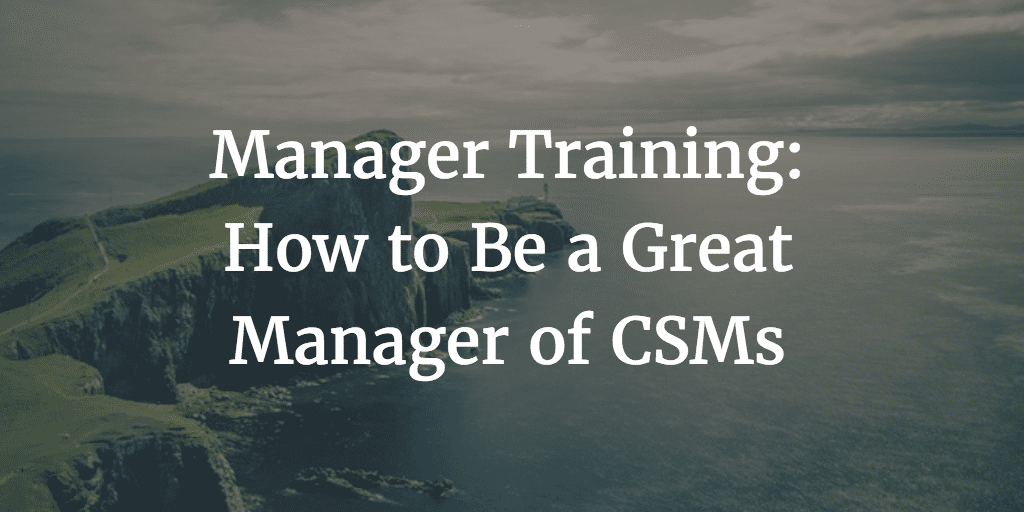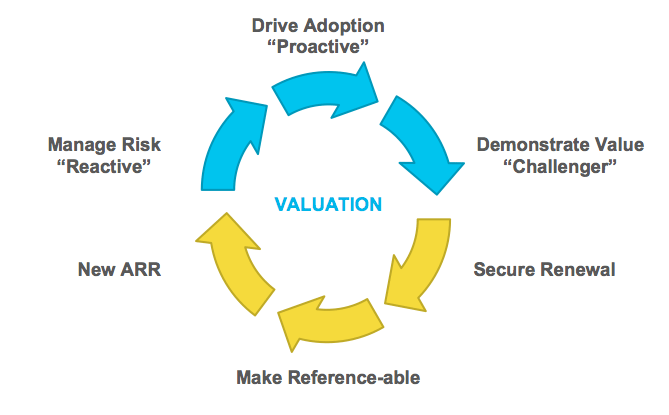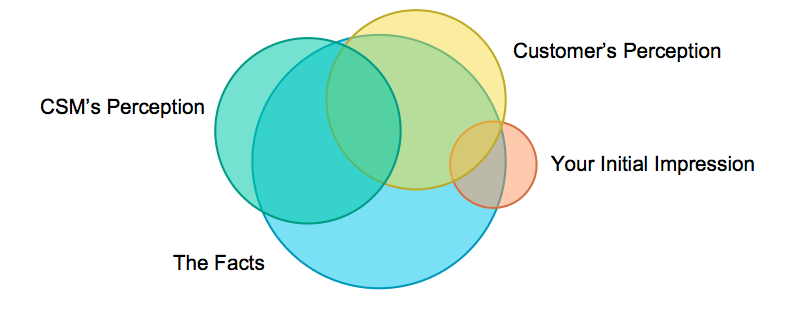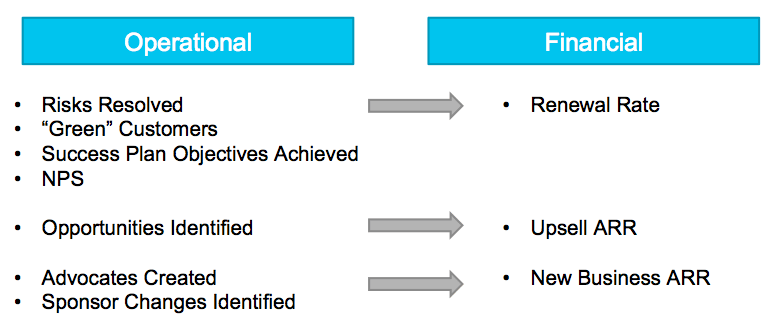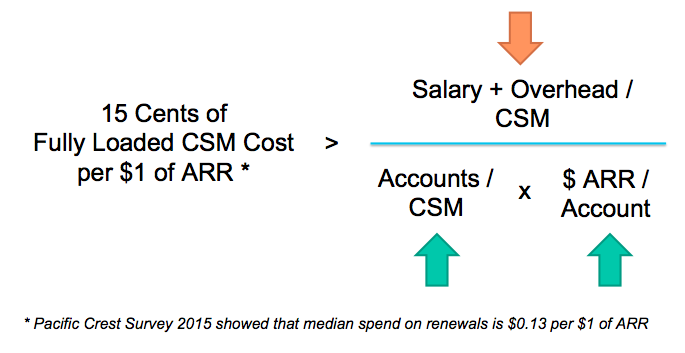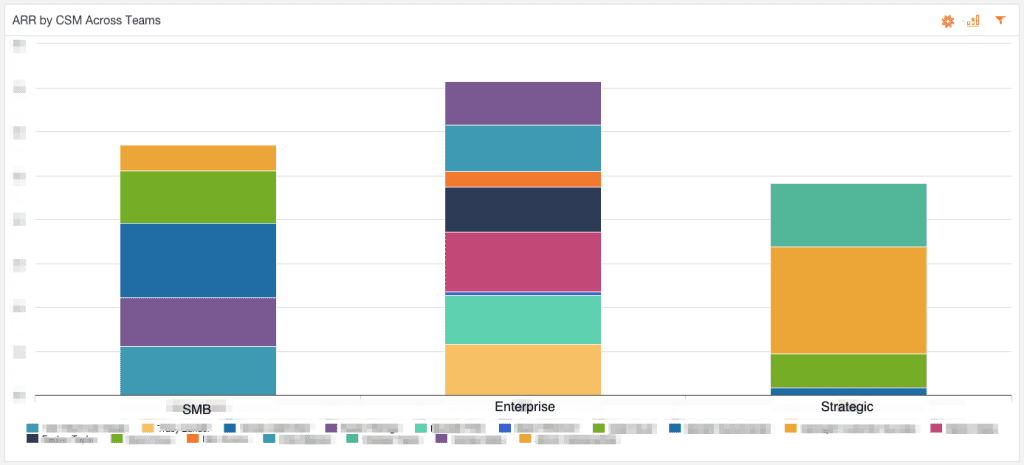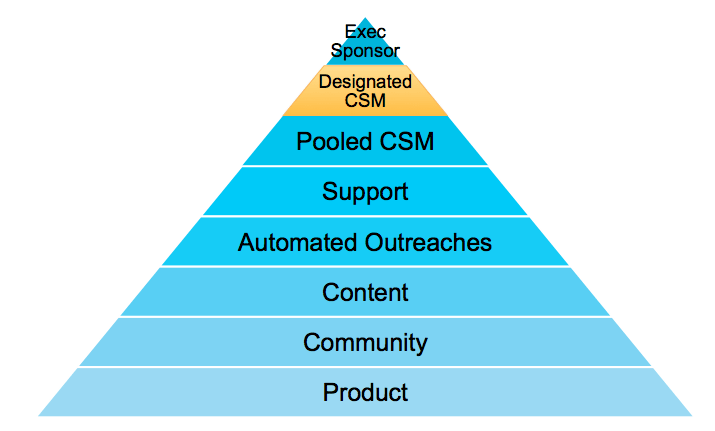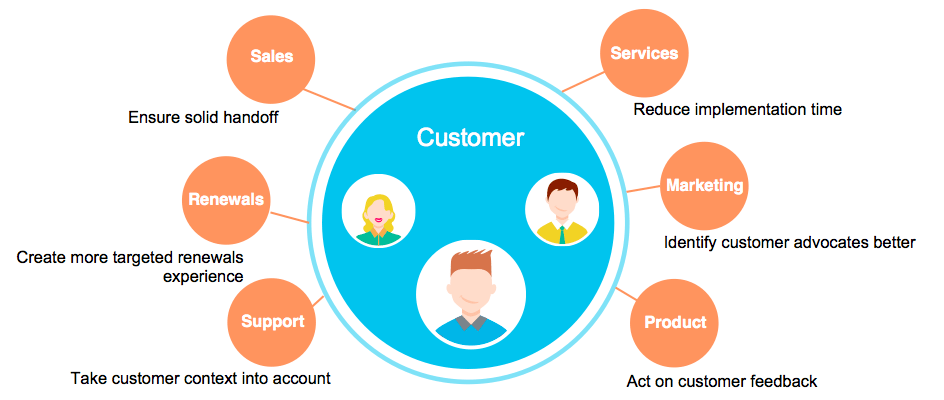Allison Pickens is VP of Customer Success & Business Operations at Gainsight
Note to Gainsight Customers: This post contains links to Vault Assets you can import directly into Gainsight.
So you just got promoted to lead a team of other CSMs. Congratulations! And don’t worry too much – we’re here for you.
Here’s a framework that encompasses the key skills a Manager should have: CAPES.
The name isn’t a coincidence; your CSMs are heroes to your customers and to your company – especially when battling the Churn Bot (see below). And as a Manager, you have to lead the pack.
CAPES stands for:
Coach
Aim
Create Predictability
Manage Escalations
Scale
Coach
To know how to coach a CSM, you need to have a strong sense of what their role should be. Here’s my definition of the role of CSM:
CSMs drive the valuation cycle.
Let’s walk through each step in this diagram.
Your CSM’s job begins from the moment your Sales team brings in a customer (New ARR). A CSM’s most basic responsibility is to manage risk – to be Reactive to customer escalations. In addition, over the past several years there’s been a big push in the CS industry to transform CSMs into more Proactive drivers of customers’ adoption of their product.
It’s not enough for customers to use your product, though; they actually need to derive value from that usage. To this end, your CSM must serve as a Challenger to your customers. I’m referring to a sales methodology called the “Challenger Sale,” described in a book by Matthew Dixon and Brent Adamson. The Challenger methodology is equally applicable to Customer Success, as I’ll describe below.
Being a Reactive/Proactive Challenger allows your CSM to pave the way for the Renewal, as well as Advocacy, which leads back to New ARR – whether in the form of upsell or new customers.
It’s the efficiency of this cycle that drives your company’s valuation. CSMs help increase your valuation as a multiple of revenue by (a) increasing your gross renewal rate and (b) reducing the cost of acquiring New ARR, by enabling organic upsell and increasing the likelihood that your existing customers acquire new customers for you (rather than your company investing more in sales and marketing).
So how should you coach your CSMs on each element of this valuation cycle?
1. Manage Risk (Reactive)
Tell your CSMs:
- Never be surprised: Being blindsided on a call is an avoidable mistake.
- Always know the next steps: Be prepared and explicit in stating these in conversations with your manager.
- “Driver” mentality: Get it done! Drive to action!
- Stay positive: In Customer Success more than in other functions, positivity is paramount because we handle so many tricky scenarios every day. Positive and negative energy are both contagious. One bad apple can ruin the atmosphere for the rest of the team.
- Don’t wait too long to escalate: You won’t be blamed when something goes wrong. Escalating is the way that you mobilize resources for the customer’s benefit.
While we’re on the topic of “blaming”: It’s critical that a Manager withhold judgment on the root cause of the problem when a risk arises. There are 3 reasons for this: (a) the real cause is often not evident at first glance, (b) if you incorrectly blame your CSM, you may well alienate them, so you better be sure, and (c) you want to encourage CSMs to escalate risks; blaming them discourages it.
Here’s what a Risk Situation usually looks like:
When you initially hear about the situation, you have inadequate information at your disposal (in orange). The information available to you may not completely coincide with the customer’s perception, which may be based on some real facts, but possibly not all the facts (since the customer may not have full knowledge of the problem), and possibly some incorrect data. Your CSM’s initial understanding of the problem is probably also limited for similar reasons and may not coincide with the customer’s perception.
Your job as Manager is to uncover the full scope of facts so that you can coach the CSM to choose the right path forward, to make sure the customer is fully aware of the situation and next steps, and to prevent the issue from happening again.
Always withhold judgment on who’s to blame until you have all the facts.
2. Drive Adoption (Proactive)
Tell your CSMs:
- Follow a consistent process: There’s no excuse for not doing what’s proven to be best practice — unless your CSM has a cool idea, in which case, make it part of your process!
- Never satisfied with “a good meeting”: Meetings are not ends in themselves. They’re only as valuable as their effect on your metrics. We’ve all had “happy ears” in meetings, meaning we hear positivity when we want to hear it. Believe the meeting is successful when you see tangible results.
- Empower the customer: It’s easy to get into the trap of doing things for the customer. Teach them to fish. Tough love: It’s better for them.
- Get creative: When you set adoption targets, it will force creative thinking. Encourage your CSMs to brainstorm tactics to drive adoption.
3. Demonstrate Value (Challenger)
Share with your CSMs some insights from the “Challenger Sale” methodology that I believe equally apply to Customer Success:
- New and different view of the world: Customers expect their vendors to be thought leaders. Share new insights with them.
- Understand the customer’s business model: What would make their business successful? How does your product support those business objectives?
- Prescriptive with a vision: Customers want you to have an opinion.
- Willing to push customers intellectually: Challenge a customer’s assumptions if you think they’re not serving him/her well. Guide the customer to the best approach, even if it’s not the most comfortable one.
- Drive to real value: Usage isn’t value. Bridge the gap.
4. Renewal
- Impact made well in advance: Saving a renewal last-minute is extremely painful and often impossible. Save yourself the stress by doing all the work upfront.
- Ownership mindset: Sales might be completing the paperwork, but the CSM should feel that it’s their responsibility to get the renewal 99% of the way there.
- Provide the right information: Set the Account Executive up for success.
- Never blindside Sales: Make sure your notes in Gainsight are up-to-date.
5. Make Reference-able
We focus on a few types of advocacy activities that move the needle for us. The CSM talks to the customer about the opportunity and then connects them either with Sales or Marketing to complete the advocacy activity.
- Sales Reference: Customer speaks to a prospective customer
- Testimonial: Customer provides ROI metrics that show they’re getting measurable value
- Event Participation: Customer speaks at an event that prospects attend
Aim
As a Manager, you’ll need to hold your team accountable for certain metrics. Certain day-to-day operational metrics contribute to longer-term financial ones:
In addition, you’ll need to keep costs under control as you pursue these metrics. In particular, companies aim to spend less than 15 cents of fully-loaded CSM cost for every $1 of ARR. As a Manager, you have three levers to manage costs, shown on the right-hand side of the formula below.
You can learn more about how to manage these three levers here.
As a Manager, you should track your account ratios carefully through a chart like the one below, which shows ARR by CSM for each Manager (learn how to configure this report here):
Create Predictability
Ensuring predictable results for the metrics above requires new processes. And to implement a new process well, you’ll have to manage your team through change, which is sometimes difficult. We recommend creating routines for using Gainsight in order to foster process change.
Here are our best practices for managing through change using Gainsight:
Best Practice: Set clear expectations
- CSMs should create a Success Plan for each customer after aligning on their objectives for the given period (e.g. the current quarter)
- CSMs should check Cockpit every morning
- Review Customer 360 dashboard before all customer calls and internal strategy meetings
- Set specific usage goals (e.g. 5 Cockpit page views per week per CSM)
Best Practice: Positive reinforcement
- Leverage Gainsight usage reports (reach out to your Customer Success resource to turn these on).
- Offer prizes for top users
- Send weekly Gainsight “spotlights” to the team (e.g. “Carrie saw her customers’ NPS improve by 10 points in the last quarter!”)
- Point out the beneficial results from a CSM escalating a risk (“Great job – you preempted what might have turned into a bad situation!”), to encourage them to continue to raise the red flag
Best Practice: Run team meetings with Dashboards
- Recognize top performers for certain metrics (e.g. Habits scorecard movement)
- Highlight success stories that the metrics reveal
- Review themes (e.g. NPS trends)
Best Practice: Run process meetings with Cockpit
- At-Risk Customers Meeting — filter for Flagged Risk CTAs
- Support Escalation Meeting — filter for Flagged Support Risk CTAs
- Renewal Meeting with Sales — filter for Renewals CTAs
Best Practice: 1-on-1s
- Review priorities using Flagged CTAs in Cockpit
- Drill through to Customer360 when a question about a customer arises
- Review overall trends in Green and Red customers using the Scorecard Dashboard
Best Practice: Enable Feedback
- Hold weekly Office Hours with your Gainsight administrator for the team to offer feedback on how the new processes are working
- “Close the Loop” by reporting back to your CSMs on how their feedback was addressed
Best Practice: Elevate Gainsight Power Users
- Pair Power Users with new CSMs or less active Gainsight users to help the latter get up to speed
Manage Escalations
Executives need team managers to serve as the first line of defense when a CSM needs help with an escalation. (You can’t include a VP in every tricky meeting!) You can read more about our escalation process here.
You can reduce the likelihood of escalations by building relationships with executives at your customers in the following ways:
- Join Executive Business Reviews: Your CSM should lead the conversation, but you should plan to have an active speaking role.
- Meet new executive sponsors: When there’s a new executive at your customer, join the initial meeting.
- Regular executive check-in’s: Plan to check in with executives on a regular cadence. You can even set CTAs to remind you to do so.
You can read more about how we manage relationships with executives at our customers here.
Scale
Besides running the show day-to-day, you can play an important role in helping your boss build a scalable Customer Success organization. Here are three ways you can do that:
1. Focus on scalable assets
Instead of asking for headcount every time your CSMs get busy, ask for greater investment in scalable assets.
The most scalable asset is your Product. That’s because in one fell swoop, a single product change can make a massive difference across your customer base. Are your CSMs spending time “filling the gaps” in your Product by helping customers hack together solutions to their problems? Offer feedback to your Product team.
Your Community is the second-most scalable asset, since it allows customers to answer each other’s’ questions. Content comes next because it can be used again and again (up to a point). From there, Automated Outreaches set up by your Gainsight administrator in Copilot can allow you to distribute that Content in a smart way.
Focus on investing in the bottom of the period so that you can build a sustainable business.
2. Understand the root cause of high workload
To reduce workload, you have to understand how your CSMs are spending their time.
The Gainsight chart below allows you to see the number of Risk CTAs opened each month in different Risk categories (e.g. Support Risk, Sentiment Risk, Product Risk, and others.) In this particular chart, Support Risk CTAs represent a large percentage of the total. This should tell you that your CSMs are spending a lot of time following up with your Support team on escalated tickets. Instead of asking for more headcount, see if you can inspire your Support team to create better processes that improve ticket resolution time. Learn how to configure this chart here.
3. Drive cross-functional coordination
Your CSMs can’t resolve every customer issue by themselves. They’ll need help from other departments.
For any given customer scenario, a CSM should serve as the quarterback on behalf of the customer to get the required help from other departments. But as their Manager, you’ll need to develop strong relationships with your peers in other departments to help grease the wheels. You’ll need to present Customer Success as a company imperative – not just a function – in order to get help. You should also take the lead on proposing and implementing improvements in cross-functional processes.
Vault Assets mentioned in this post
(for Gainsight customers only)
Here are ready-to-use versions of what you’ve seen in this post:
If you’d like to learn more about how to implement these processes in your organization, check the Business Processes section of Gainsight Go, check out the Vault, or contact your CSM. You can also send questions or feedback to Allison at apickens@gainsight.com. Follow her blog posts on Twitter @PickensAllison.
